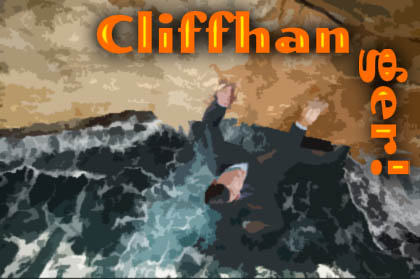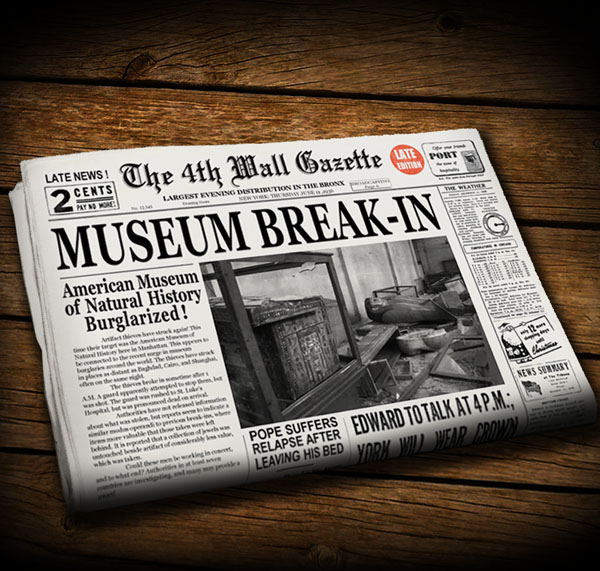April 9, 2017
Four Secrets about Writing a Cliffhanger your Dentist Doesn’t Want You to Know

The cliffhanger is an ancient storytelling device. In The Odyssey, Homer leaves his audience hanging over the fate of Telemachus for eleven books after he walks into an ambush. In One Thousand and One Nights, Sheherezade avoids being executed by her husband, the king, through telling him a story every night that would end in a cliffhanger. Every morning, her execution would be stayed so that he could hear more. It wasn’t until the late 1800’s that the cliffhanger got its name, though. It came from a serialized Tom Hardy novel, A Pair of Blue Eyes, where the hero was left hanging from a cliff staring into the eye sockets of a fossilized skull.
Harrowing Adventures is a serial adventure in the style of the pulps of the ‘30s and ‘40s, so cliffhanger endings are absolutely essential. And there are several pitfalls to avoid when creating cliffhangers that delight your readers. An author must leave the audience wanting more, but when they finally get more, the wait better have been worth it. By ending a chapter or an episode on a cliffhanger, the author is making a promise to the reader. They are saying, “I’m going to make you wait, but when you find out what happens, the story will be much better for it.” It’s a pact, and so it requires trust, and that only comes over time. The author gives the reader a great story, and the reader is going to return (and possibly pay money) to enjoy it. If the reader returns and doesn’t find a satisfying resolution, they may not pay to be disappointed again.
Let’s talk about some ways to execute a cliffhanger poorly. Bad cliffhangers tend to arise from a disconnect between how the cliffhanger was laid down and how it’s picked up later. A simple one to avoid is the cliffhanger with no payoff. It’s the anti-cliffhanger. The author introduces a tense moment, and then breaks; then when the story resumes, it’s revealed that there was never anything to be tense about in the first place. It’s a dirty trick an author plays on their reader. Consider this example: “Just then, the door flew open and a man stepped in holding a gun. ‘I knew I’d find you here, Frank.’ To be continued…” That’s not too bad, right? But suppose the audience waits for two months and returns to read, “The door flew open and a man stepped in holding a gun. ‘I knew I’d find you here, Frank.’ It was Jimmy. He held out the gun in his open palm and said, ‘Here you go, I cleaned and oiled your gun just like you asked.” No matter how die-hard a fan is, they’re not going to be pleased when they return and read that.
Another kind of cliffhanger to avoid involves the resolution requiring some information that the reader wasn’t privy to beforehand. Here, the author writes what could be a satisfying resolution to a cliffhanger, but fails to set it up properly. Consider the following: A thug is strangling the life from Margot and the story ends with her reaching for her purse as she’s on the verge of blacking out. Later, the story resumes and she reaches into her purse, pulls out a jar of hot spices, and smashes it in the thugs face. A reader will be satisfied, but only if they were present with her in the Egyptian market when she haggled over the price of those spices as a gift for her aunt. If the author failed to set that up beforehand, no amount of retroactive explanation can correct this. The resolution feels too ad hoc, and robs the reader of the payoff.
Possibly the most egregiously offensive type of cliffhanger, though, is one where the author just changes the facts of the scenario later. This is a lesson I first had pointed out to me explicitly by Stephen King via Annie Wilkes in the novel Misery. If the story ends with, “Dr. Burroughs speeds over the ledge, his car trailing a long streak of flame,” it had better not resume with, “The professor dives out of the car at the last minute, watching it sail over the ledge trailing a long streak of flame.”
Everything I just said applies to click bait headlines. They pull you in because cliffhangers are so enticing. Then they let you down because they generally rely on one of the above strategies to deliver their content. You can only be burned so many times before you swear only to give in when it involves cats or sloths, because the payoff is virtually guaranteed.
As I write this, it occurs to me that the internet era has given us another kind of cliffhanger to be avoided. It came to my attention through the response to the Negan cliffhanger in The Walking Dead, but it was also present in Jon Snow’s death. This is the dramatic cliffhanger where the wait is too long, the ramifications are too important, the audience is large and devoted, and perhaps the options for resolution are too limited. A cliffhanger like this can surprise and please its audience if they only have to wait a short time, but drop one of these in between books or television seasons and thanks to the power of the internet, people have the means, time, and motivation to team up to work out exactly how things should go down to have the most dramatic effect. If the resolution is less amazing than what they’ve devised, they’ll be disappointed. If it’s exactly what they expected, they’ll be disappointed. Was anyone surprised by the Jon Snow cliffhanger by the time Game of Thrones resumed? Fortunately, there wasn’t an outcry, because the show presented it with a wink. Nobody actually thought that was going to be a permanent situation. On the other hand, The Walking Dead fell into this trap with Negan. Had the payoff come the following week, the fans wouldn’t have had time to work it all out, and people wouldn’t have been upset at the already predicted resolution.
So I’ve spent a lot of time talking about what makes a bad cliffhanger, and maybe that’s good. Every other blog post on the internet seems to be focused on telling you how to do them well, not how to avoid screwing them up. But I guess it’s time to tell you what my preferences are, and what Mark and I are doing to make sure our cliffhangers are good ones.
First of all, I prefer the cliffhanger that comes after a rewarding climax. Frank defeats a nefarious mafia boss, Hooray! But before he dies, the boss says that he knew he’d never win, so he rigged the building with explosives, and he reaches for the switch. To be continued… This gives the player a sense of accomplishment, something that would normally come with a relief from tension, but instead you ratchet it up even more and stop right there. That’s a huge and dramatic chapter-ending kind of cliffhanger. But, the multiplayer nature of Harrowing Adventures creates opportunities for lots of little cliffhangers, too.
While a player can advance in the story beyond their colleagues, they can only do it to a point. Mark and I strive to fill those points with mini-cliffhangers. Revelations of new clues that re-frame some part of the adventure and flood a player with new questions can be a wonderful cliffhanger to stew on while waiting for a buddy to get off work and catch up in the game. Margot drops her flashlight and breaks it in a cavern underground not knowing whether anyone else is down there. That kind of cliffhanger might cause a player to call their friend and coax them into venturing down into the cavern to bail them out. I see nothing wrong with that. In fact, that’s exactly the kind of involvement we’re hoping we can inspire in our players.
Mark and I can’t wait for you to play our adventures, and we promise we’ll do everything in our power to never leave you with a substandard cliffhanger.

